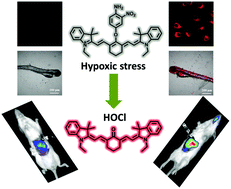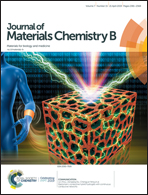Detection of hypochlorous acid fluctuation via a selective near-infrared fluorescent probe in living cells and in vivo under hypoxic stress†
Abstract
Hypoxic stress is a common concern in medicine and biology, which can induce the cellular injury and death by excess production of reactive oxygen species (ROS). Hypochlorous acid (HOCl), one of the ROS, plays a crucial role in the oxidative damage to tissue proteins in the pathogenesis of various diseases. Therefore, excess production of HOCl might be an important factor for the damage caused by hypoxic stress. However, most of the present methods cannot meet the demand of real-time detection on account of the labile and reactive chemical properties of HOCl. Herein, we designed a near-infrared fluorescent probe, Cy-HOCl, for the selective imaging of HOCl in cells and in vivo. Cy-HOCl includes two moieties: a 4-amino-3-nitrophenol group as the response unit and a near-infrared heptamethine cyanine fluorophore as the fluorescent modulator. Cy-HOCl exhibits excellent selectivity and sensitivity towards the detection of HOCl. The hypoxic response behavior of Cy-HOCl is evaluated in cells to clarify the relationship between HOCl and hypoxia. The probe is also applied to measure HOCl in ex vivo-dissected organs of an acute ischemia mouse model as well as for real-time monitoring the changes of HOCl in the hypoxic zebrafish model.



 Please wait while we load your content...
Please wait while we load your content...